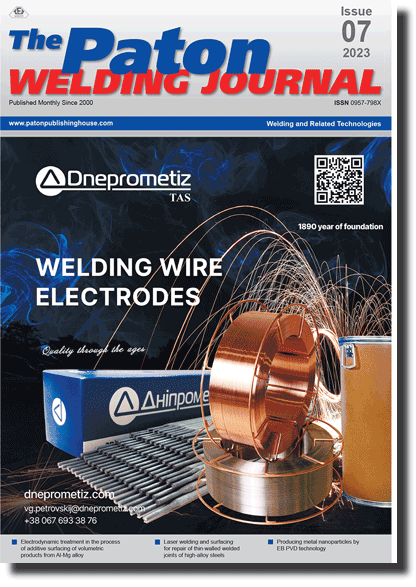| 2023 №07 (04) |
DOI of Article 10.37434/tpwj2023.07.05 |
2023 №07 (06) |

The Paton Welding Journal, 2023, #7, 37-42 pages
Technologies for producing low-hydrogen fused fluxes
I.O. Goncharov, V.V. Holovko, A.P. Paltsevych, A.M. Duchenko
E.O. Paton Electric Welding Institute of the NASU. 11 Kazymyr Malevych Str., 03150, Kyiv, Ukraine. E-mail: goncharovia@ukr.netAbstract
The influence of the technology of producing welding fluxes on the content of hydrogen in them and nature of its thermal desorption was investigated. From the fluxes produced by the method of duplex process (sequentially operating gas flame and electric arc furnace), hydrogen is mainly removed at temperatures to 600 °С. It was established that the content of diffusion hydrogen in the deposited metal in welding under the fused fluxes, produced by the method of duplex process, is approximately by 30 % lower compared to fluxes produced in gas-flame furnaces. The use of fused semi-products in the composition of a charge while producing agglomerated fluxes was proposed. 12 Ref., 3 Tabl., 2 Fig.
Keywords: hydrogen, automatic arc welding under the fused fluxes
Received: 19.06.2023
Accepted: 06.09.2023
References
1. Milos B. Djukic, Gordana M. Bakic, Vera Sijacki Zeravcic et al. (2016) Hydrogen embrittlement of industrial components: Prediction, prevention, and models. Corrosion, 72 (7), 943-961. https://doi.org/10.5006/19582. Vigdis Olden, Antonio Alvaro, Odd M. Akselsen (2012) Hydrogen diffusion and hydrogen influenced critical stress intensity in an API X70 pipeline steel welded joint: Experiments and FE simulations. Int. J. of Hydrogen Energy, 37(15), 11474-11486. https://doi.org/10.1016/j.ijhydene.2012.05.005
3. Poznyakov, V.D. (2023) Welding technologies for repair of metal structures. Kyiv, PWI [in Ukrainian].
4. Tianli Zhang, Zhuoxin Li, Frank Young et al. (2014) Global progress on welding consumables for HSLA steel. ISIJ Intern., 8, 1472-1484. https://doi.org/10.2355/isijinternational.54.1472
5. Poznyakov, V.D. (2017) Welding technologies for manufacturing and repair of metal structures from high-strength steels. Visnyk NANU, 1, 64-72 [in Ukrainian]. https://doi.org/10.15407/visn2017.01.064
6. Pokhodnya, I.K., Yavdoshchyn, I.R., Paltsevych, A.P. et al. (2004) Metallurgy of arc welding. Interaction of metal with gases. Kyiv, Naukova Dumka [in Ukrainian].
7. Goncharov, I.A., Paltsevich, A.P., Tokarev, V.S. (2001) Effect of hydrogen in low-alloyed weld metal on pore formation in submerged arc welding. The Paton Welding J., 7, 20-23.
8. Podgaetsky, V.V., Lyuborets, I.I. (1984) Welding fluxes. Kyiv, Tekhnika [in Russian].
9. Zhdanov, L.A., Duchenko, A.N., Goncharov, I.A. et al. (2012) Thermodynamic analysis of slag melts in manufacture of fused welding fluxes. The Paton Welding J., 11, 23-27.
10. Zalevsky, A.V., Galynych, V.I., Osypov, M.Ya. et al. (2001) Method of manufacture of fused welding fluxes. Pat. Ukraine, Publ. 16.07.2001 [in Ukrainian].
11. Volkov, V.V., Kasatkin, B.S., Mikhajlov, V.E. (1985) Comparison of methods for determination of hydrogen content in welds. Avtomatich. Svarka, 6, 36-38.
12. Goncharov, I.A., Paltsevich, A.P., Tokarev, V.S. et al. (2001) About the form of hydrogen existence in welding fused fluxes. The Paton Welding J., 4, 27-30.
Suggested Citation
I.O. Goncharov, V.V. Holovko, A.P. Paltsevych, A.M. Duchenko (2023) Technologies for producing low-hydrogen fused fluxes. The Paton Welding J., 07, 37-42.The cost of subscription/purchase order journals or individual articles
| Journal/Currency | Annual Set | 1 issue printed |
1 issue |
one article |
| TPWJ/USD | 384 $ | 32 $ | 26 $ | 13 $ |
| TPWJ/EUR | 348 € | 29 € | 24 € | 12 € |
| TPWJ/UAH | 7200 UAH | 600 UAH | 600 UAH | 280 UAH |
| AS/UAH | 1800 UAH | 300 UAH | 300 UAH | 150 UAH |
| AS/USD | 192 $ | 32 $ | 26 $ | 13 $ |
| AS/EUR | 180 € | 30 € | 25 € | 12 € |
| SEM/UAH | 1200 UAH | 300 UAH | 300 UAH | 150 UAH |
| SEM/USD | 128 $ | 32 $ | 26 $ | 13 $ |
| SEM/EUR | 120 € | 30 € | 25 € | 12 € |
| TDNK/UAH | 1200 UAH | 300 UAH | 300 UAH | 150 UAH |
| TDNK/USD | 128 $ | 32 $ | 26 $ | 13 $ |
| TDNK/EUR | 120 € | 30 € | 25 € | 15 € |
AS = «Automatic Welding» - 6 issues per year;
TPWJ = «PATON WELDING JOURNAL» - 12 issues per year;
SEM = «Electrometallurgy Today» - 4 issues per year;
TDNK = «Technical Diagnostics and Non-Destructive Testing» - 4 issues per year.


